Mock polls portend of worse to come on May 10
Independent observers’ reports show a different picture
At least 50 percent to 75 percent of the country’s expected 50 million voters may be unable to vote on May 10.
This possible widespread voters’ disenfranchisement may likely happen based on the results of the Feb. 6 mock elections held by the Commission on Elections (Comelec) in five selected cities of the country.
This finding and other glitches documented during the mock polls portend of things to come on May 10.
Researchers of CenPEG as well as AES Watch, Kontra Daya, Pagbabago, and other poll watch groups observed the mock elections in Quezon City, Taguig City, and in the cities of Baguio, Cebu, and Davao.
Comelec officials, who declared the mock elections a “success,” may have overlooked the findings of independent researchers, political analyst Bobby Tuazon said.
Fifty voters were selected for each of the voting centers with the use of the Precinct Count Optical Scan (PCOS), canvassing computers, and transmission system.
Reports by CenPEG and data received from other observer groups showed the average voting time – excluding powering up the machine to official closing time – ranged from one to two hours. Translated to actual voting time on May 10 with 1,000 voters in every clustered precinct, voting time could last from 22 to 40 hours. With the May 10 election limited to 11 hours, this could mean from 500 to 750 voters in every clustered precinct being unable to vote or roughly 50-75 percent of the electorate.
This scenario will most likely happen unless Comelec plugs in the loophole and make sure all 1,000 voters can cast their votes on election day, the CenPEG mock election observers said.
Still, there were other problems seen during the mock polls. Some of these indicated that the mock elections may have been staged as a showcase with trials already conducted days before February 6.
CenPEG reports revealed that pre-tests were conducted in the schools a day before the mock election. In Taguig, the test was conducted on the ground floor of the school where signal was poor. The mock election was held on February 6 on the second floor.
Similarly, in Tandang Sora, Quezon City teachers also acted as mock voters. At the Gen. Ricardo Papa High School in Taguig many of the voters were teachers and city hall employees.
At the Maharlika High School, Taguig, tension briefly erupted when the preselected voters found their names missing in the Voters’ List. There were also discrepancies between the names listed on the Comelec officers’ Voters’ List and those in the Voters’ List posted outside the polling center.
Automating the election will not deter flying voters. At Maharlika, for instance, one voter voted twice after the BEI failed to put an indelible ink on her finger after voting.
The Board of Election Inspectors (BEIs), particularly at the New Era elementary school, knew nothing about what to do with rejected ballots.
“After two tries and the ballot was still rejected, the voters surrendered the ballot to the BEI and they just walked out of the voting room with no proper assessment on why their ballot was rejected,” said an observer from CenPEG.
Poll watchers also complained of lack of transparency in the whole process. Most of the time they were restricted from going near the PCOS machine to observe the displays on the LCD screen.
In many of the mock voting centers, policemen and military men posted themselves in violation of the election law that restricts security forces to at least 50 meters from the precinct area.
At the Alejandra Navarro Elementary School in Davao, the BEIs did not give a copy of the ER and the audit log report to the poll watchers for scrutiny.
Poll watchers are concerned that with this lack of transparency, public participation in the electoral process is further compromised.
AES Watch spokesperson and UP Alumni Association president Alfrefo Pascual urged the Comelec to conduct an “honest to goodness” mock elections to fully test the capability of the system.
He said that Comelec should randomly select precincts and involve a large number of registered voters. Actual ballots should also be used and the manual audit of the results included.
Mock elections should be held in the rural barrios and remote areas involving 1,000 voters. This way, CenPEG researchers said, the automated election system can be tested in real conditions unlike in selected cities where power and transmission systems are least likely unstable.
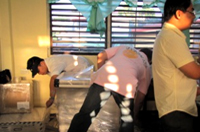
Poll personnel unwrap voting machine at Tuktukan school, Taguig (CenPEG photo)
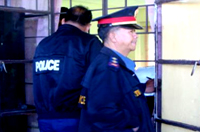
Police inside a mock voting center in Baguio (Photo by John Panem for CenPEG)
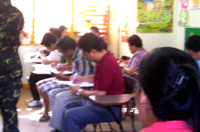
Mock voters fill in ballots in Cebu. Note half-hidden uniformed soldier at left. (CenPEG photo)
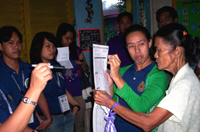
An elderly voter gives a quizzical look at the long ballot at the Bulacao elementary school in Cebu (CenPEG photo)
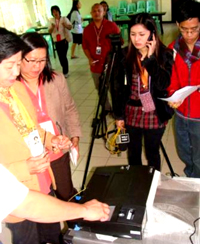 In Baguio: Poll personnel and observers watch as PCOS machine is initialized (Photo by John Panem for CenPEG)
In Baguio: Poll personnel and observers watch as PCOS machine is initialized (Photo by John Panem for CenPEG)
- Probing presidential platforms
- Conference calls for people-centered policy actions for Asian development and peace
- WWII 'comfort women' urge visiting Japanese emperor: OFFICIAL GOV’T APOLOGY, UPHOLD TRUTH, and JUST COMPENSATION
- FEARLESS FORECAST (EPISODE II): Comelec will not comply with e-Commerce Law in 2016 elections
- Fearless forecast: Comelec’s non-compliance with the AES law in 2016 (last of 2 parts)
- Fearless forecast: Comelec will not comply with the AES law in 2016
- CenPEG releases travelogue
- Experts: Nuisance bets reflect disillusionment, uneven playing field
- Partylist solon presses for tax cuts
- The True Cost of a Political Campaign
- Management decisions: Based on RA 9369 or purely Comelec’s?
- CenPEG holds 1st roundtable with media on presidential poll results
- Filipino IT can do it!
- FIT4E: The only transparent solution
- Realpolitik in the maritime tiff
- China’s challenge to PH sovereignty
- Choosing the next president
- Fixing the presidency, reforming the state
- New Comelec chair says he’s open to other election technologies
- SC ruling on AES Watch Pabillo and IBP vs Comelec, Smartmatic-TIM
- Comelec must explain P3.2B unliquidated cash advances
- CONGRESS ASKED TO HOLD DEMO ON PCOS HACKING
- 25 Bishops ask poll body to stop midnight deal with Smartmatic
- Pope Francis: reform and conversion
- 2 poll watch coalitions stage rally vs Comelec-Smartmatic midnight deal
- AES Watch questions Comelec-Smartmatic midnight deal
- ASEAN-India: Building Youth Partnerships through Culture and Entrepreneurship
- CenPEG forges research exchange and partnership with Jinan University
- FOI: Bearing fruit or foiled again?
- Remittance with Representation: The right to vote of overseas Filipinos
Center for People Empowewrment in Governance (CenPEG), Philippines. All rights reserved


